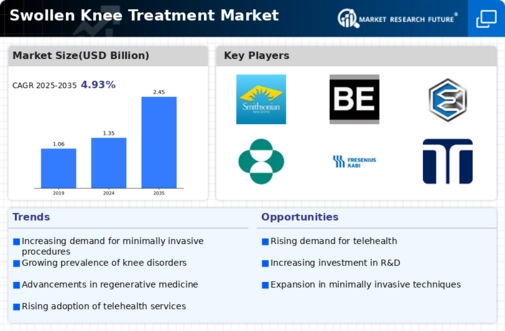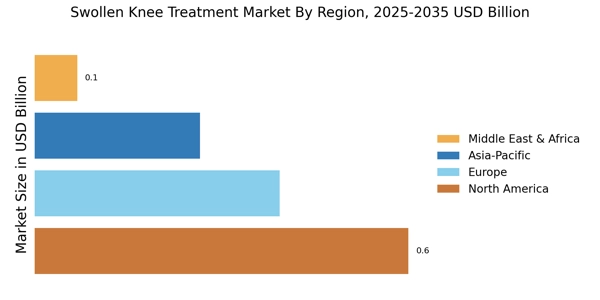Rising Awareness of Knee Health
There is a notable increase in public awareness regarding knee health and the implications of untreated knee conditions, which serves as a significant driver for the Swollen Knee Treatment Market. Educational campaigns and health initiatives aimed at promoting joint health have led to a greater understanding of the importance of early intervention. This heightened awareness encourages individuals experiencing knee swelling to seek medical advice sooner, thereby increasing the patient pool for treatment options. Furthermore, the proliferation of online health resources and community support groups has empowered patients to take proactive steps in managing their knee health. As awareness continues to grow, the Swollen Knee Treatment Market is poised for expansion, with more individuals actively pursuing treatment for swollen knees.
Advancements in Treatment Technologies
Technological innovations in the field of orthopedics and rehabilitation are transforming the Swollen Knee Treatment Market. The introduction of minimally invasive surgical techniques, such as arthroscopy, has revolutionized the approach to treating swollen knees, allowing for quicker recovery times and reduced hospital stays. Additionally, advancements in regenerative medicine, including stem cell therapy and platelet-rich plasma (PRP) treatments, are gaining traction as viable options for knee treatment. These technologies not only enhance treatment efficacy but also improve patient outcomes, thereby driving market growth. As healthcare providers increasingly adopt these advanced treatment modalities, the Swollen Knee Treatment Market is likely to witness a surge in demand for innovative solutions that address knee swelling and associated disorders.
Aging Population and Lifestyle Changes
The demographic shift towards an aging population is a critical factor influencing the Swollen Knee Treatment Market. As individuals age, the likelihood of developing knee-related issues increases, leading to a higher demand for treatment options. Additionally, lifestyle changes, such as increased sedentary behavior and obesity, exacerbate the prevalence of knee disorders. Data indicates that nearly 40% of adults aged 65 and older experience knee pain, highlighting the urgent need for effective treatment solutions. This demographic trend is prompting healthcare systems to adapt and expand their offerings in the Swollen Knee Treatment Market, ensuring that appropriate care is available for the growing number of affected individuals. Consequently, the market is expected to experience sustained growth as treatment options evolve to meet the needs of this aging population.
Increasing Prevalence of Knee Disorders
The rising incidence of knee disorders, including osteoarthritis and rheumatoid arthritis, is a primary driver of the Swollen Knee Treatment Market. According to recent data, approximately 30 million adults in the United States are affected by osteoarthritis, leading to a significant demand for effective treatment options. This trend is mirrored in various regions, where aging populations and sedentary lifestyles contribute to the prevalence of knee-related ailments. As more individuals seek medical intervention for swollen knees, the market for treatment options, including medications, physical therapy, and surgical procedures, is expected to expand. The growing awareness of knee health and the importance of timely treatment further fuels this demand, indicating a robust growth trajectory for the Swollen Knee Treatment Market.
Integration of Holistic Treatment Approaches
The shift towards holistic treatment approaches in healthcare is emerging as a significant driver for the Swollen Knee Treatment Market. Patients increasingly seek comprehensive care that addresses not only the physical aspects of knee swelling but also the psychological and emotional components. This trend has led to the incorporation of complementary therapies, such as acupuncture, massage therapy, and nutritional counseling, alongside conventional medical treatments. Research suggests that patients who engage in holistic care often report improved outcomes and satisfaction levels. As healthcare providers recognize the value of integrating these approaches, the Swollen Knee Treatment Market is likely to expand, offering a wider array of treatment options that cater to the diverse needs of patients experiencing swollen knees.


















Leave a Comment